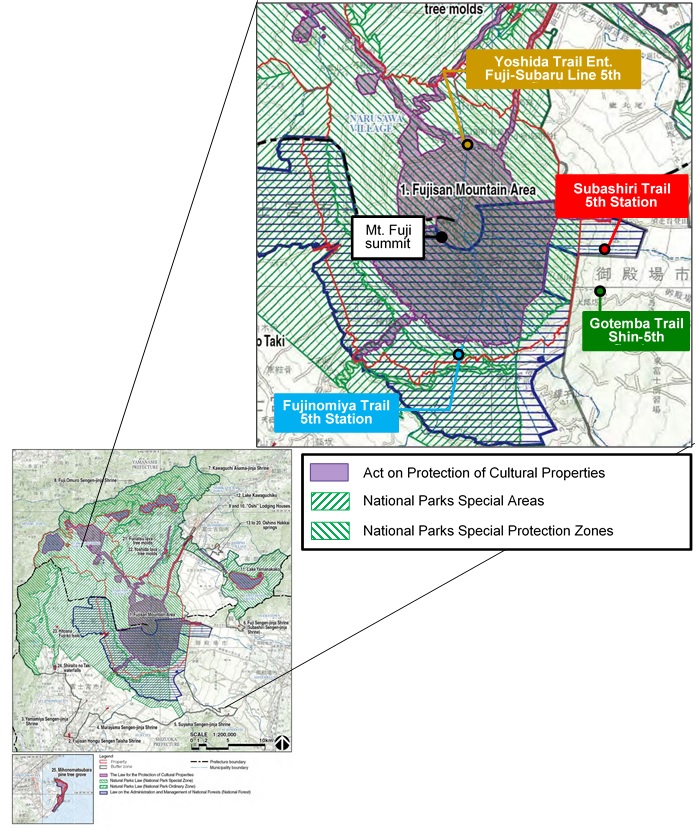Protection of Cultural Properties and Fujisan World Cultural Heritage
Protection of Cultural Properties
Mt. Fuji and most of the foothill areas are designated as a Special Place of Scenic Beauty and Historic Site under the Law for the Protection of Cultural Properties. Changing the current status or affecting their conservation of special places of scenic beauty and historic sites without permission will be punished under the law.

World Cultural Heritage
Twenty-five historic sites related to the history and culture of Mt. Fuji and its surrounding areas were collectively registered as a World Cultural Heritage Site in June 2013 as "Fujisan, sacred place and source of artistic inspiration." Once feared for its repeated eruptions, Fujisan has also been an object of worship due to its natural blessings such as springs at the foothills and its beautiful shape. Fujisan has had a large influence on the Japanese people's view of nature and on Japanese culture.
Outstanding universal value of Mt. Fuji
Fujisan is the tallest mountain in Japan and has been an object of worship historically. It has a special presence to the Japanese people. Long ago, Fujisan was a place of frequent volcanic activity and a center for the Shugen-d sect, which combined traditional Japanese mountain worship with the non-native religion of Buddhism. Many Shugen-do believers came to worship as they climbed Fujisan towards its peak. Also, people would look up at its peak from the foothills and worship it from afar. Years later, ordinary persons called Doja would come to the mountain's peak. Beginning from the 17th century, the Fujisan worship known as Fuji-ko began to grow in popularity. Large numbers of Fuji-ko worshippers who visited from afar ascended the mountain and made pilgrimages to sacred sites located among the foothills. Oshi Lodging Houses and other facilities were also created to support the climbers and arrange the procedures. Even today, during the summer climbing season, the mountain sees large numbers of visitors who climb to its peak, with some worshipping the Goraiko sunrise and performing the ritual walk along the Ohachimeguri Trail around the crater rim.
With both magnificence and great beauty, Fujisan has been a source of artistic inspiration not only for Japanese people, but also for artists from other countries. It has inspired the creation of countless works of art and has been the subject of paintings, literature, poems, and theater plays. It is featured in classical works such as the Man-yoshu, which was compiled in the 8th century and is the oldest existing collection of Japanese poetry, and the oldest prose narratives in Japan such as Taketori Monogatari and Ise Monogatari, as well as in haiku and Chinese poetry. After the Heian period, Ukiyoe woodblock prints depicting Fujisan became popular, with well-known examples including “Thirty-six Views of Mt. Fuji” by Katsushika Hokusai and “Fifty-Three Stations of the Tokaido” by Utagawa Hiroshige. These were exported overseas and had a large impact on western artists such as Van Gogh and Monet. The value of Fujisan as a source of artistic inspiration has not faded in recent times, and the mountain has been portrayed in the folding-screen painting “Gunjo Fuji” (Fujisan Dyed Ultramarine) by Yokoyama Taikan, as well as in literary works by Natsume Soseki and Dazai Osamu.
- Common Problems and Solutions
- Rules and Regulations
- National Park Dos and Don'ts
- Protection of Cultural Properties and Fujisan World Cultural Heritage
- Other Rules and Regulations
- Etiquette/Manners on Mt. Fuji
- Toilets on the Trails
- Staying on the Right Track
- Avoid Mountain Accidents
- How to Walk Efficiently
- Injuries and Illnesses
- Emergency Contact Information


